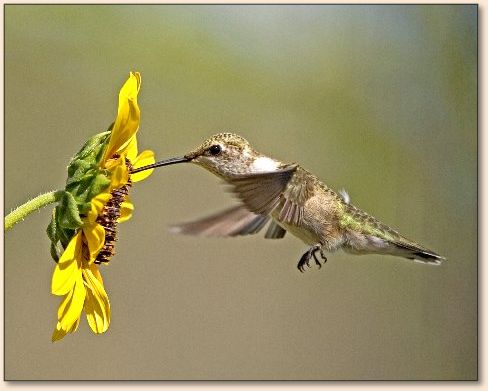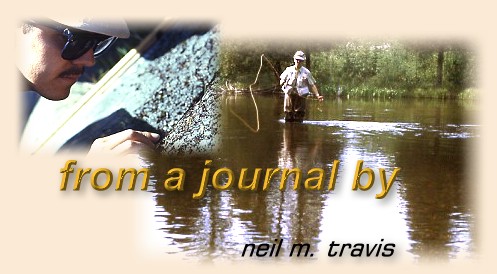Organization
By Neil M. Travis, Montana/Arizona
In last weeks column I wrote about taking a minimalist
approach to fly fishing gear and from some of the comments
that were posted on the bulletin board it must have hit a
responsive chord among some of my readers. It should be
understood that I did not intend to insinuate that anglers
who take a semi full of gear with them each time they go
fishing are doing it wrong. What I was suggesting was we
all might find that we have more fun with a little less
stuff. I have been chasing fish with flies for almost a
half century, and having taught both fly casting and fly
tying at various times during those years so I have
accumulated more than my share of excess gear. However, what
I have observed is that much of that stuff never gets used. I
have rods that have not seen the light of day for years, flies
that have never been on the water, and a variety of gadgets
and widgets that I have never used. If I started tying a dozen
flies each day it is unlikely that in my remaining years of life
that I could use up all of the fly tying stuff that I have
gathered over the years. If that sounds like you perhaps you
can learn from my mistakes.
Being a minimalist does not mean that you cannot experiment
with new patterns, or that you can't own a closet full of
gear. It does not mean that you don't own two nippers, more
than one pair of waders, an extra hemostat or more than one
pair of Polarized glasses. It simply means that when you go
fishing you don't carry every one of them with you on the
stream. Unless you enjoy being a beast of burden each time
you go angling I would suggest you might consider a more
modified approach to the sport.
One of the responses posted on the bulletin board said they
only carried a few soft hackle caddis patterns because they
are the type of flies which are dominate on the waters they
regularly fish. They supplement those few patterns when they
travel to other places, but on their home water these few
patterns are sufficient. This is an excellent approach for
the angler who only regularly fishes in one area. The angler
who has identified the patterns that work on a regular basis
can spend more time doing what they came to do, namely fishing,
and less time trying to figure out what fly to use.
For those anglers who travel around to various places another
system must be adopted. What works on stream A will not suffice
for stream B which has entirely different hatches. This is the
situation that I enjoy in Montana, and I find it necessary to
have a variety of flies and even different types of equipment
to cover the various angling situations that I encounter. This
calls for organization to insure that I don't arrive on DePuy's
Spring Creek with flies that are only suitable for fishing on
the Yellowstone River.
The place to get organized is at home and not when you are
standing along the stream in your waders. First, all your
flies should be sorted by type and size. Dry caddis patterns
should be in one box, midge pupa in another, etc. I don't put
size 12 dry flies in the same box with size 18 midges for the
simple reason that I have yet to encounter a situation where
I needed both at the same time. If you fish in a place where
you have the need for both sizes during the same day then I
would suggest that you have them in separate boxes.
What patterns and sizes that you carry on any given trip
will be influenced by what type of trip you are taking. If
you are fishing from your vehicle, unless you have to walk
a considerable distance before you start fishing, you can
carry less gear. If you find that there is a certain size
or pattern that is necessary a quick trip back to the vehicle
is all that is required to remedy the problem. If you are
fishing from a boat or using a float tube or pontoon and
returning to the vehicle would not be practical or expedient
you might want to carry extra flies. When floating this is
not a problem since it is not necessary that you pack them
in your vest.
At the risk of offending, as if that normally would be a
problem for a retired judge, I would suggest that some
degree of minimalism will force you to become a better
angler. If you are going to be a successful minimalist
you must know what flies are going to be needed, and to
obtain that knowledge you must apply yourself to learning
everything that you can about the places where you fish.
When you carry a limited number of patterns you are more
likely to be more observant, take more time to study each
situation, and choose your imitation more carefully. You
will spend less time changing flies or search through your
fly box and more time actually fishing, and that has to be
a good thing.
If minimalism is not your idea of a good time don't let
me spoil your fun, but I challenge you to keep track of
the stuff that you use each year and the stuff that never
sees the light of day. You might be surprised at how much
stuff you would never miss if you did not carry it with you. ~ Neil M. Travis, Montana/Arizona
Publisher's Note:
Neil emailed me that he would be working on banding hummingbirds
Monday morning at Madera Canyon, Arizona. Below is a photo he sent of
a banded immature Black-chinned Hummingbird. Can you see the band?

From A Journal Archives
|

